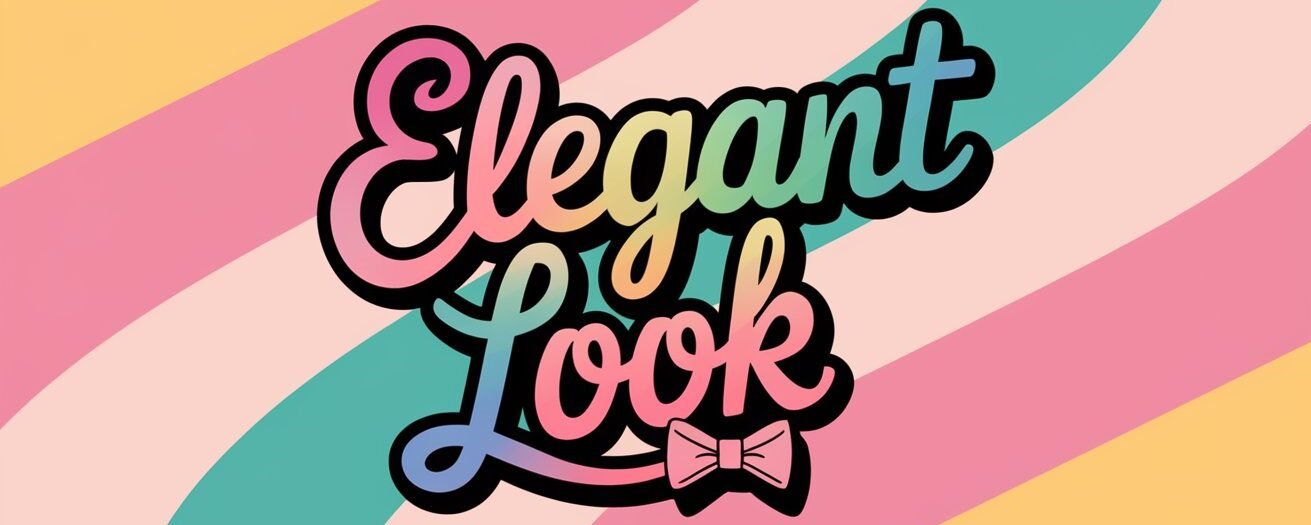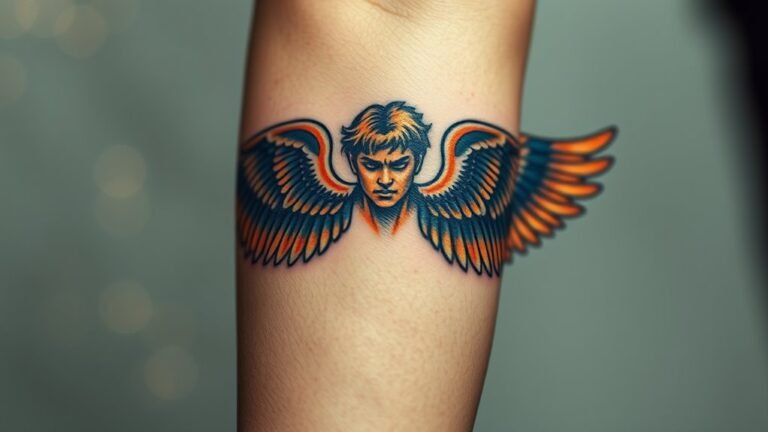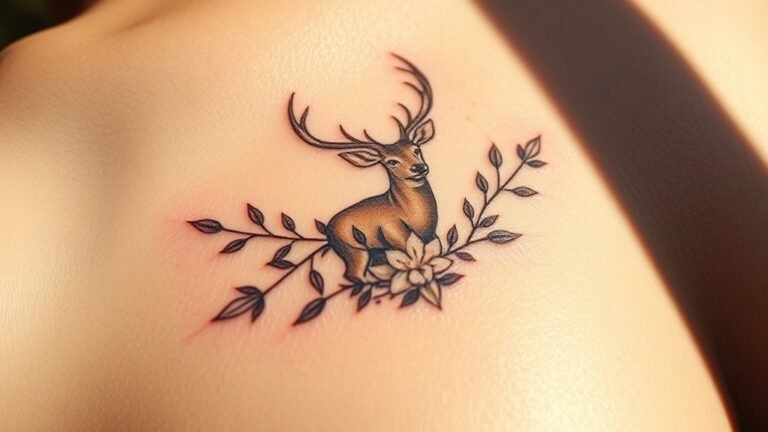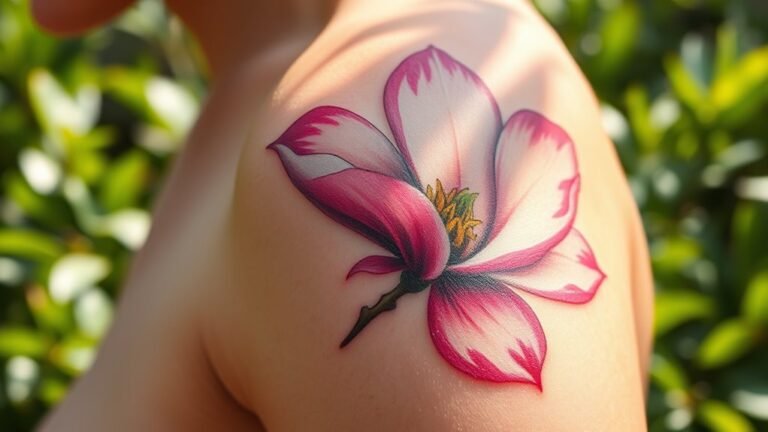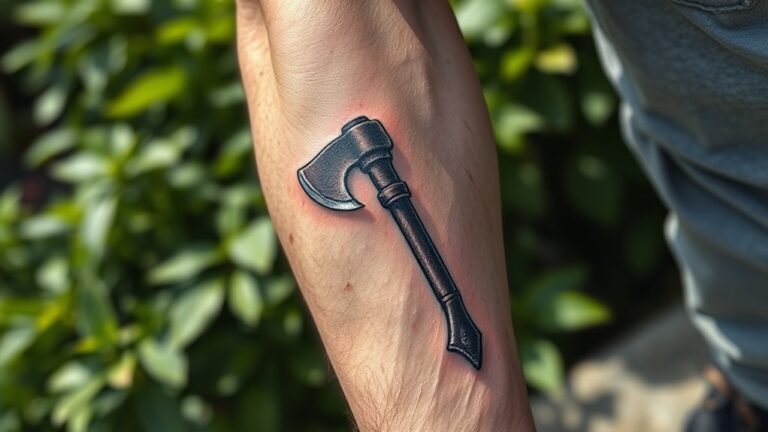Gaara’s Tattoo Meaning and Symbolism
When you consider Gaara's tattoo, the kanji for "love," it becomes clear that the symbol extends far beyond its surface meaning. It encapsulates his journey from profound isolation to a yearning for connection, reflecting the complexities of his character. This stark emblem serves as a reminder of his past traumas while simultaneously highlighting his resilience. But what deeper implications does this tattoo have on his identity and relationships within the "Naruto" universe? Exploring these dimensions reveals much more than you'd expect.
In a Nutshell
- Gaara's tattoo features the kanji for "love" (愛), symbolizing his journey from loneliness to acceptance and belonging.
- The tattoo serves as a visual representation of Gaara's tumultuous past and emotional scars, marking his transformation.
- Positioned prominently on his forehead, the tattoo contrasts with Gaara's pale skin, emphasizing his struggles with isolation and mistrust.
- The symbolism of love in Gaara's tattoo reflects his internal battles and desire for meaningful connections.
- Ultimately, the tattoo represents hope for the future, illustrating Gaara's evolution from an outcast to a beloved leader.
Overview of Gaara's Character
Although Gaara starts as a feared antagonist in "Naruto," his character arc reveals deep emotional scars and a quest for identity.
You see, Gaara's personality traits, such as his intense loneliness and overwhelming anger, stem from his traumatic childhood experiences. Isolated by his own village, after being treated as a weapon due to his mother's curse, he grows up believing love is unattainable.
This painful background shapes him into a cold figure, seemingly indifferent to human connection. Yet, beneath that tough exterior lies a yearning for acceptance and belonging.
As you explore Gaara's journey, you'll discover how his battles aren't just external but also internal, as he seeks to redefine himself beyond the pain of his past.
The Kanji Symbol for Love
Love, a profound and complex emotion, is encapsulated in the kanji symbol "愛" (ai), which serves as a poignant reminder of Gaara's transformation throughout "Naruto."
This character, once consumed by solitude and resentment, bears this symbol prominently on his forehead, signifying not only his struggle with love but also his eventual acceptance of it.
The kanji's significance lies in its representation of love in various forms—self-love, familial bonds, and friendship.
As you explore Gaara's journey, you recognize how he evolves from isolation to connection.
This tattoo isn't just an emblem; it reflects his desire for belonging and understanding.
In embracing love, Gaara ultimately discovers his own humanity, connecting deeply with those around him.
Origins of Gaara's Tattoo
Gaara's tattoo, prominently featured on his forehead, has roots that stretch deep into his backstory and the lore of the Hidden Sand Village. This tattoo design, which resembles the kanji for "love," serves as a pivotal symbol of his tumultuous past.
Born into a world of loneliness and mistrust, the tattoo embodies the struggle to find acceptance and connection. The cultural significance of this marking goes beyond mere aesthetics; it reflects Gaara's journey from isolation to a sense of belonging.
It represents the weight of expectations placed on him as a Jinchuriki, highlighting his inner turmoil. Understanding the origins of Gaara's tattoo enriches your appreciation of his character and the themes of identity and acceptance woven throughout the series.
Symbolism of Love in Naruto
While the narrative of Naruto often explores themes of friendship and rivalry, the symbolism of love weaves its way through the series in profound ways, influencing character development and plot progression.
Love's resilience stands out as characters like Naruto and Sasuke navigate their complex emotional bonds. Their journey illustrates how love can mend broken relationships, fostering understanding and growth.
Additionally, the unconditional love from figures like Iruka and Sakura showcases the transformative power of connection, inspiring others to overcome darkness.
This emotional depth enriches the storyline, reminding you that love isn't just a feeling; it's a driving force.
Ultimately, the series highlights that love can be a source of strength, guiding you through life's challenges and uniting you with others.
Gaara's Journey of Loneliness
As you investigate Gaara's journey, you'll discover a profound exploration of loneliness that shapes his identity.
From a young age, the loneliness impact on Gaara's life becomes painfully evident. Abandoned and feared, he grapples with emotional struggles that leave deep scars. His experiences create a wall around him, isolating him from others and nurturing feelings of despair.
Each encounter reinforces his belief that love and acceptance are unattainable. You can see how his loneliness drives his actions, pushing him to seek power as a substitute for connection.
This quest paints a vivid picture of a person desperately trying to belong, highlighting the tragic irony of a warrior who fights not just against foes, but against the emptiness within.
The Impact of Isolation
Isolation profoundly influences Gaara's psyche, shaping his worldview and interactions with others.
You see, the isolation effects aren't just physical; they carve deep emotional scars that alter how he perceives love and connection. When you're deprived of companionship, fear and mistrust become your constant companions.
Gaara learns to build walls, believing vulnerability equates to weakness. This belief traps him in a cycle of despair, pushing away those who might offer solace.
It's a painful paradox: yearning for connection while simultaneously fearing it. You can feel his struggle, the intense battle between his longing for acceptance and the protective shell formed by isolation.
Ultimately, his emotional scars reflect a profound need for belonging that remains just out of reach.
Transformation Through Relationships
When you examine Gaara's journey, it becomes clear that relationships play an essential role in his transformation. His path to emotional healing and relationship growth highlights how connection with others can reshape your identity.
Through meaningful bonds, you witness pivotal changes, such as:
- Acceptance: Finding people who see you beyond your scars fosters a sense of belonging.
- Support: Genuine connections offer strength during your most vulnerable moments.
- Empathy: Sharing experiences with others nurtures understanding, allowing you to break down emotional barriers.
These relationships not only help Gaara embrace his true self, but they also remind you that love and friendship can ignite profound change.
Embracing such connections can lead you to a more fulfilling, authentic life.
The Role of Redemption
While you navigate the complexities of Gaara's character, it becomes evident that redemption is a powerful catalyst for transformation. His redemption arc highlights the profound journey from isolation to connection, reflecting a deep yearning for belonging.
You witness his struggles, which resonate with anyone seeking personal growth. As he confronts his past, Gaara learns to embrace vulnerability, allowing others in and discovering the strength found in relationships.
This shift not only reshapes his identity but also redefines his purpose. The tattoo he bears becomes a symbol of this metamorphosis, illustrating how redemption can rewrite one's narrative.
Ultimately, Gaara's story invites you to reflect on how embracing change and seeking forgiveness can lead to a more fulfilling existence.
Tattoo's Connection to Identity
As Gaara navigates his identity, his tattoo serves as a powerful emblem of who he's and what he's overcome. This ink isn't just a mark; it's a form of identity expression that encapsulates his journey. The personal significance of his tattoo resonates deeply, reminding you of your own struggles and triumphs.
Consider how this connection might reflect your experiences:
- Struggles with acceptance—feeling like an outsider in your own skin.
- The search for belonging—yearning for a place that feels like home.
- Transformation through adversity—emerging stronger from your challenges.
Gaara's tattoo embodies a shared narrative of resilience, inviting you to explore your identity and the stories that shape you.
Visual Representation in the Series
Gaara's tattoo not only represents his internal struggles but also manifests visually in the series, enhancing the narrative's depth.
The character design incorporates visual symbolism that speaks volumes about his journey. The tattoo, a prominent feature on his forehead, signifies his isolation and pain, while also embodying his transformation.
As you watch, you notice how the tattoo's stark contrast against his pale skin draws your attention, reminding you of his turbulent past. This deliberate design choice reinforces his identity, making it clear that every aspect of Gaara is intertwined with his experiences.
Ultimately, the visual representation of his tattoo invites you to explore themes of acceptance and belonging, resonating with anyone who feels misunderstood or out of place.
Fan Interpretations and Theories
Many fans have explored the significance of Gaara's tattoo, interpreting it as a symbol of both his struggle for identity and his desire for connection.
Through character analysis, fan theories suggest that the tattoo represents his internal battles and longing for acceptance. Here are three poignant interpretations that resonate deeply with many:
- Isolation: The tattoo embodies Gaara's loneliness, a constant reminder of his past.
- Transformation: It signifies his journey from a feared outcast to a beloved leader, highlighting resilience.
- Hope: Fans believe it reflects his desire for meaningful relationships, representing a yearning for love.
These interpretations not only deepen your understanding of Gaara but also resonate with those who seek belonging and connection in their own lives.
Legacy of Gaara's Tattoo
Though often seen as merely a visual mark, the legacy of Gaara's tattoo extends far beyond its surface, influencing both character development and thematic exploration within the series.
The tattoo's significance reflects Gaara's journey from isolation to acceptance, embodying the struggle for belonging that resonates with many. Its cultural influences draw from traditional Japanese symbolism, representing the pain and resilience inherent in his character.
As you explore Gaara's story, you'll see how this mark serves as a reminder of his past while symbolizing hope for the future.
The tattoo becomes a bridge connecting his identity to broader themes of love, loss, and redemption, inviting you to reflect on your own experiences of finding a place within a community.
Frequently Asked Questions
What Does Gaara's Tattoo Look Like in Different Anime Adaptations?
In various anime adaptations, you'll notice Gaara's tattoo styles differ subtly. From bold, dark lines to softer hues, these anime variations enhance his character's depth, reflecting his journey and emotional evolution throughout the series.
How Did Fans Initially React to Gaara's Tattoo Design?
When fans first saw Gaara's tattoo design, they enthusiastically shared fan theories about its design inspiration. Many felt it reflected his complex character and deep struggles, sparking conversations that fostered a sense of belonging within the community.
Are There Any Official Merchandise Featuring Gaara's Tattoo?
You'll find various merchandise featuring Gaara's tattoo, including apparel and accessories. Tattoo replicas are available too, allowing you to express your fandom and connect with others who appreciate Gaara's unique character and story.
Did Gaara's Tattoo Change Throughout the Series?
Yes, Gaara's tattoo evolves alongside his character design. As you observe his journey, notice how its changes reflect his emotional growth, illustrating his transformation from isolation to acceptance, creating a deeper connection to his identity.
Are There Cultural Influences Behind Gaara's Tattoo Design?
You might find that Gaara's tattoo reflects rich cultural symbolism, drawing design inspiration from traditional Japanese art. Its unique aesthetics connect to deeper themes of identity, struggle, and resilience, resonating with your own experiences and emotions.
